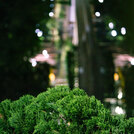
Trees with small leaf size and high leaf complexity and trees with long "in leaf" periods like evergreens generally make the most effective barriers against roadside pollution and offer the most air quality benefits, according to a review of literature for 61 tree species. While tree selection is important, where trees are planted is the most important factor to whether a given species will be beneficial or detrimental to air quality. While vegetative buffers can reduce pollution exposure at a local scale, reduced emissions are the most effective pollution reduction strategy.
Barwise, Yendle, and Prashant Kumar. “Designing vegetation barriers for urban air pollution abatement: a practical review for appropriate plant species selection” npj Climate and Atmospheric Science 3, no. 12 (2020). https://doi.org/10.1038/s41612-020-0115-3.
